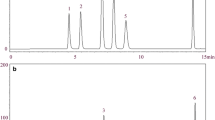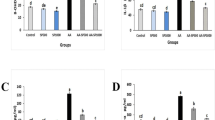Abstract
Semen Strychni has been widely used as a traditional Chinese herb medicine, but its clinical use was limited for its potential neurotoxicity and nephrotoxicity. This study aimed to investigate S. Strychni-induced neurotoxicity and the neuro-protective effect of Paeonia lactiflora based on monitoring nine potential neurotoxicity biomarkers in rat serum and brain tissue. A sensitive liquid chromatography-tandem mass spectrometry method was developed and validated to monitor serotonin, tryptophan, dopamine, tyrosine and glutamate in serum and five brain regions (prefrontal cortex, hippocampus, striatum, cerebellum and hypothalamus). Analytes were separated on a CAPCELL CORE PC column (150 mm × 2 mm, 2.7 μm) with a gradient program of acetonitrile-water (0.2 % formic acid) and a total runtime of 7.5 min. In addition, enzyme-linked immunosorbent assay was conducted to determine four kinds of protein (tryptophan hydroxylase, tyrosine hydroxylase, endogenous brain-derived neurotrophic factor and nerve growth factor). Results demonstrated that the administration of S. Strychni could cause certain endogenous substances disorder. These analytes were found significantly changed (p < 0.05) in serum (except glutamate) and in certain tested brain regions in S. Strychni extract group. Pretreatment of P. lactiflora could significantly reverse the S. Strychni-induced neurotoxicity and normalize the levels of such endogenous substances. The study could be further used in predicting and monitoring neurotoxicity caused by other reasons, and it was expected to be useful for improving clinical use of S. Strychni through pretreatment with P. lactiflora.







Similar content being viewed by others
References
Adermark L, Clarke RBC, Olsson T, Hansson E, Soderpalm B, Ericson M (2011) Implications for glycine receptors and astrocytes in ethanol-induced elevation of dopaminelevels in the nucleus accumbens. Addict Biol 16:43–54
Alfaro-Rodriguez A, Gonzalez-Pina R, Bueno-Nava A, Arch-Tirado E, Avila-Luna A, Uribe-Escamilla R, Vargas-Sanchez J (2011) Metab Brain Dis 26:213–220
Archer J (1973) Tests for emotionality in rats and mice: a review. Anim Behav 21:205–235
Arundine M, Tymianski M (2004) Molecular mechanisms of glutamate-dependent neurodegeneration in ischemia and traumatic brain injury. Cell Mol Life Sci 61:657–668
Betancourt AM, Burgess SC, Carr RL (2006) Effect of developmental exposure to chlorpyrifos on the expression of neurotrophin growth factors and cell-specific markers in neonatal rat brain. Toxicol Sci 92:500–506
Birdsall NJM, Farries T, Gharagozloo P, Kobayashi S, Kuonen D, Lazareno S, Pogham A, Sugimoto M (1997) Selective allosteric enhancement of the binding and actions of acetylcholine at muscarinic receptor subtypes. Life Sci 60:1047–1052
Blum D, Torch S, Lambeng N, Nissou M, Benabid AL, Sadoul R, Verna JM (2001) Molecular pathways involved in the neurotoxicity of 6-OHDA, dopamine and MPTP: contribution to the apoptotic theory in Parkinson’s disease. Prog Neurobiol 65:135–172
Branchi I, Campolongo P, Alleva E (2004) Scopolamine effects on ultrasonic vocalization emission and behavior in the neonatal mouse. Behav Brain Res 151:9–16
Cao C, He X, Wang W, Zhang L, Lin H, Du L (2006) Kinetic distribution of paeoniflorin in cortex of normal and cerebral ischemia-reperfusion rats after intravenous administration of Paeoniae Radix extract. Biomed Chromatogr 20:1283–1288
Chan TYK (2002) Herbal medicine causing likely strychnine poisoning. Hum Exp Toxicol 21:467–468
Chen J, Hou T, Fang Y, Chen ZP, Liu X, Cai H, Lu TL, Yan GJ, Cai BC (2011) HPLC Determination of Strychnine and Brucine in Rat Tissues and the Distribution Study of Processed Semen Strychni. Yakugaku Zasshi 131:721–729
De Souza Silva MA, Mattern C, Topic B, Buddenberg TE, Huston JP (2009) Dopaminergic and serotonergic activity in neostriatum and nucleus accumbens enhanced by intranasal administration of testosterone. Eur Neuropsychopharmacol 19:53–63
Donner N, Handa RJ (2009) Estrogen receptor-beta regulates the expression of tryptophan hydroxylase 2 mRNA within serotonergic neurons of the rat dorsal raphe nuclei. Neuroscience 163:705–718
Dreyfus CF (1998) Neurotransmitters and neurotrophins collaborate to influence brain development. Perspect Dev Neurobiol 5:389–399
Fišar Z, Hroudová J (2010) Intracellular signalling pathways and mood disorders. Folia Biol 56:135–148
Goni-Allo B, Puerta E, Mathuna BO, Hervias I, Lasheras B, de la Torre R, Aguirre N (2008) On the role of tyrosine and peripheral metabolism in 3,4-methylenedioxymethamphetamine-induced serotonin neurotoxicity in rats. Neuropharmacology 54:885–900
Gu LQ, Wang XF, Zhang YY, Jiang Y, Lu H, Bi KS, Chen XH (2014) Determination of 12 potential nephrotoxicity biomarkers in rat serum and urine by liquid chromatography with mass spectrometry and its application to renal failure induced by Semen Strychni. J Sep Sci 37:1058–1066
Hernandez TD, Schallert T (1988) Seizures and recovery from experimental brain damage. Exp Neurol 102:318–324
Ho SL, Poon CY, Lin C, Yan T (2015) Inhibition of beta-amyloid aggregation by albiflorin, aloeemodin and neohesperidinand their neuroprotective effect on primary hippocampal cells against beta-amyloid induced toxicity. Curr Alzheimer Res 12:423–433
Huang GZ, Wang DW (2004) Forensic Toxicology. People’s Medical Publishing House, Beijing
Huang H, Zhao J, Jiang L, Xie Y, Xia Y, Lv R, Dong L (2015) Paeoniflorin improves menopause depression in ovariectomized rats under chronic unpredictable mild stress. Int J Clin Exp Med 8:5103–5111
Issaq HJ, Fox SD, Chan KC, Veenstra TD (2011) Global proteomics and metabolomics in cancer biomarker discovery. J Sep Sci 34:3484–3492
Jett DA (2012) Chemical toxins that cause seizures. Neurotoxicology 33:1473–1475
Karlsson E, Jolkkonen M, Mulugeta E, Onali P, Adem A (2000) Snake toxins with high selectivity for subtypes of muscarinic acetylcholine receptors. Biochimie 82:793–806
Khan MS, Tabrez S, Priyadarshini M, Priyamvada S, Khan MM (2012) Targeting Parkinson’s-Tyrosine Hydroxylase and Oxidative Stress as Points of Interventions. Cns Neurol Disord-Drug Targets 11:369–380
Kinawy AA, Ezzat AR, Al-Suwaigh BR (2014) Inhalation of air polluted with gasoline vapours alters the levels of amino acid neurotransmitters in the cerebral cortex, hippocampus, and hypothalamus of the rat. Exp Toxicol Pathol 66:219–224
Lan Z, Chen L, Fu Q, Ji W, Wang S, Liang Z, Qu R, Kong L, Ma S (2013) Paeoniflorin attenuates amyloid-beta peptide-induced neurotoxicity by ameliorating oxidative stress and regulating the NGF-mediated signaling in rats. Brain Res 1498:9–19
Lee KY, Jeong EJ, Lee HS, Kim YC (2006) Acteoside of Callicarpa dichotoma attenuates scopolamine-induced memory impairments. Biol Pharm Bull 29:71–74
Li X, Wang K, Wei W, Liu YY, Gong L (2013) In vitro metabolism of brucine by human liver microsomes and its interactions with CYP substrates. Chem Biol Interact 204:140–143
Li SJ, Zhang MY, Hou PY, Zhang RW, Hou CZ, Bi KS, Chen XH (2015) Identification of the toxic components in Semen Strychni and their metabolites in rat serum by high performance liquid chromatography coupled with a Q Exactive high-resolution benchtop quadrupole Orbitrap mass spectrometer. RSC Adv 5:77689–77698
Liu F, Wang XL, Han X, Tan XX, Kang WJ (2015) Cytotoxicity and DNA interaction of brucine and strychnine—Two alkaloids of semen strychni. Int J Biol Macromol 77:92–98
Longa EZ, Weinstein PR, Carlson S, Cummins R (1989) Reversible middle cerebral artery occlusion without craniectomy in rats. Stroke 20:84–91
Lubbers LS, Zafian PT, Gautreaux C, Gordon M, Alves SE, Correa L, Lorrain DS, Hickey GJ, Luine V (2010) Estrogen receptor (ER) subtype agonists alter monoamine levels in the female rat brain. J Steroid Biochem Mol Biol 122:310–317
Mackerer CR, Kochman RL, Shen TF, Hershenson FM (1977) The binding of strychnine and strychnine analogs to synaptic membranes of rat brainstem and spinal cord. J Pharmacol Exp Ther 201:326–331
Nam KN, Yae CG, Hong JW, Cho DH, Lee JH, Lee EH (2013) Paeoniflorin, a monoterpene glycoside, attenuates lipopolysaccharide-induced neuronal injury and brain microglial inflammatory response. Biotechnol Lett 35:1183–1189
Nestler EJ, Terwilliger RZ, Duman RS (1989) Chronic antidepressant administration alters the subcellular distribution of cyclic AMP-dependent protein kinase in rat frontal cortex. J Neurochem 53:1644–1647
Palmer AM, Marion DW, Botscheller ML, Swedlow PE, Styren SD, Dekoshy ST (1993) Traumatic brain injury-induced excitotoxicity assessed in a controlled cortical impact model. J Neurochem 61:2015–2024
Patocka J (2009) Chapter 14 - Strychnine, Handbook of Toxicology of Chemical Warfare Agents. Academic, USA, pp 199–205
Philippe G, Angenot L, Tits M, Frédérich M (2004) About the toxicity of some Strychnos species and their alkaloids. Toxicon 44:405–416
Purves-Tyson TD, Handelsman DJ, Double KL, Owens SJ, Bustamante S, Weickert CS (2012) Testosterone regulation of sex steroid-related mRNAs and dopamine-related mRNAs in adolescent male rat substantia nigra. BMC Neurosci 13:1471–2202
Reichardt LF (2006) Neurotrophin-regulated signalling pathways. Philos Trans R Soc London B 361:1545–1564
Sai Y, Chen JF, Ye F, Zhao YP, Zou ZM, Cao J, Dong ZJ (2013) Dopamine Release Suppression Dependent on a Increase of Intracellular Ca2+ Contributed to Rotenone-induced Neurotoxicity in PC12 Cells. J Toxicol Pathol 26:149–157
Scardapane L, Cardinali DP (1977) Effect of estradiol and testosterone on catechol-O-methyl transferase activity of rat superior cervical ganglion, pineal gland, anterior hypophysis and hypothalamus. J Neural Transm 40:81–86
Slotkin TA, Seidler FJ, Fumagalli F (2007) Exposure to organophosphates reduces the expression of neurotrophic factors in neonatal rat brain regions: similarities and differences in the effects of chlorpyrifos and diazinon on the fibroblast growth factor superfamily. Environ Health Perspect 115:909–916
Song JJ, Hou XT, Hu XY, Lu CY, Liu CG, Wang J, Liu W, Teng LR, Wang D (2015) Not only serotonergic system, but also dopaminergic system involved in albiflorin against chronic unpredictable mild stress-induced depression-like behavior in rats. Chem Biol Interact 242:211–217
Sprague JE, Huang X, Kanthasamy A, Nichols DE (1994) Attenuation of 3,4-methylenedioxymethamphetamine (MDMA) induced neurotoxicity with the serotonin precursors tryptophan and 5-hydroxytryptophan. Life Sci 55:1193–1198
Thomas DM, Perez MA, Francescutti-Verbeem DM, Shah MM, Kuhn DM (2010) The role of endogenous serotonin in methamphetamine-induced neurotoxicity to dopamine nerve endings of thestriatum. J Neurochem 115:595–605
Vanhatalo S, Soinila S (1999) Inducible Expression of Tryptophan Hydroxylase without Serotonin Synthesis in Hypothalamic Dopaminergic Neurons. Exp Neurol 157:305–316
Wang SJ, Lou YQ (2011) Experimental Research of Decreasing Toxicity and Increasing Efficacy on the Compatibility of Nux Vomica. Rheumatoid Arthritis 3:78–80
Wang D, Tan QR, Zhang ZJ (2013) Neuroprotective effects of paeoniflorin, but not the isomer albiflorin, are associated with the suppression of intracellular calcium and calcium/calmodulin protein kinase II in PC12 cells. J Mol Neurosci 51:581–590
Wu YM, Jin R, Yang L, Zhang J, Yang Q, Guo YY, Li XB, Liu SB, Luo XX, Zhao MG (2013) Phosphatidylinositol 3 kinase/protein kinase B is responsible for the protection of paeoniflorin upon H2O2-induced neural progenitor cell injury. Neuroscience 240:54–62
Zhang L, Schallert T, Zhang ZG, Jiang Q, Arniego P, Li QJ, Lu M, Chopp M (2002) A test for detecting long-term sensorimotor dysfunction in the mouse after focal cerebral ischemia. J Neurosci Methods 117:207–214
Zhen XH, Quan YC, Jiang HY, Wen ZS, Qu YL, Guan LP (2015) Fucosterol, a sterol extracted from Sargassum fusiforme, shows antidepressant and anticonvulsant effects. Eur J Pharmacol 768:131–138
Acknowledgments
This research received no specific grant from any funding agency in the public, commercial, or not-for-profit sectors.
Author information
Authors and Affiliations
Corresponding authors
Ethics declarations
Conflict of interest
The authors declare that there are no conflicts of interest.
Electronic supplementary material
Below is the link to the electronic supplementary material.
ESM 1
(DOC 354 kb)
Rights and permissions
About this article
Cite this article
Shi, H., Hou, C., Gu, L. et al. Investigation of the protective effect of Paeonia lactiflora on Semen Strychni-induced neurotoxicity based on monitoring nine potential neurotoxicity biomarkers in rat serum and brain tissue. Metab Brain Dis 32, 133–145 (2017). https://doi.org/10.1007/s11011-016-9894-y
Received:
Accepted:
Published:
Issue Date:
DOI: https://doi.org/10.1007/s11011-016-9894-y




